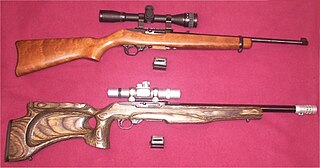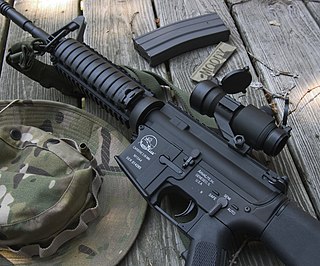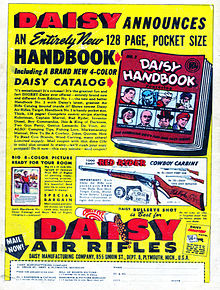
A rifle is a long-barreled firearm designed for accurate shooting and higher stopping power, with a barrel that has a helical pattern of grooves (rifling) cut into the bore wall. In keeping with their focus on accuracy, rifles are typically designed to be held with both hands and braced firmly against the shooter's shoulder via a buttstock for stability during shooting. Rifles are used extensively in warfare, law enforcement, hunting, shooting sports and crime.

A shotgun is a long-barreled firearm designed to shoot a straight-walled cartridge known as a shotshell, which discharges numerous small spherical projectiles called shot, or a single solid projectile called a slug. Shotguns are most commonly used as smoothbore firearms, meaning that their gun barrels have no rifling on the inner wall, but rifled barrels for shooting sabot slugs are also available.
A muzzleloader is any firearm, in which the user loads the projectile and the propellant charge into the muzzle end of the gun. This is distinct from the modern designs of breech-loading firearms, in which user loads the ammunition into the breech end of the barrel. The term "muzzleloader" applies to both rifled and smoothbore type muzzleloaders, and may also refer to the marksman who specializes in the shooting of such firearms. The firing methods, paraphernalia and mechanism further divide both categories as do caliber.

An air gun or airgun is a gun that using energy from compressed air or other gases that are mechanically pressurized and released as propellant for the chosen projectiles based on the principle of the primitive blowgun. This is in contrast to a firearm, which fires projectiles using energy by burning combustible propellants, most often gunpowder.
Airsoft, also known as survival game in Japan where it was first popularized, is a team-based shooting game in which participants eliminate opposing players out of play by tagging them with spherical plastic projectiles shot from low-power airguns called airsoft guns.

A BB gun is a type of air gun designed to shoot metallic spherical projectiles called BBs, which are approximately the same size as BB-size lead birdshot used on shotguns. Modern BB guns usually have a smoothbore barrel with a 4.5 mm (0.177 in) caliber, and use steel balls that measure 4.3–4.4 mm (0.171–0.173 in) in diameter and 0.33–0.35 g (5.1–5.4 gr) in weight, usually zinc- or copper-plated for corrosion resistance. Some manufacturers still make the slightly larger traditional lead balls that weigh around 0.48–0.50 g (7.4–7.7 gr), which are generally intended for use in rifled barrels.

Accurizing is the process of improving the accuracy and precision of a gun.
Weihrauch & Weihrauch GmbH & Co. KG is a German manufacturer of target and sporting air rifles, air pistols, cartridge rifles and pistols. In North America, they are often distributed under the Beeman brand name.

Airsoft guns are replica toy guns used in airsoft sports. They are a special type of low-power smoothbore air guns designed to shoot non-metallic spherical projectiles (pb) often colloquially referred to as "BBs", which are typically made of plastic or biodegradable resin materials. Airsoft gun powerplants are designed to have low muzzle energy ratings and the pellets have significantly less penetrative and stopping powers than conventional airguns, and are generally safe for competitive sporting and recreational purposes if proper protective gear is worn.

Crosman Corporation is an American designer, manufacturer and supplier of shooting sport products, with a long-standing presence in airgun design and a tradition of producing pellet and BB guns. Crosman is also a producer of many varieties of airgun and airsoft ammunition and CO2 Powerlet cartridges. In addition, Crosman sells branded, licensed products as well as a variety of airsoft guns.

Airsoft pellets (known as BBs) are spherical projectiles used by airsoft guns. Typically made of plastic, they usually measure around 6 mm (0.24 in) in diameter (though selective models use 8 mm), and weigh 0.20–0.40 g (3.1–6.2 gr), with the most common weights being 0.20 g and 0.25 g, while 0.28 g, 0.30 g, 0.32g and 0.40g BBs are also commonplace. Though frequently referred to as "BBs" among airsoft users, these BBs are not the same as either of the 4.5 mm metal projectiles that BB guns fire, or the 4.6 mm (0.180 in)-sized birdshot from which the term "BB" originated.
The MP-661K "Drozd" is Russian-made BB pistol and rifle.

Field target is an outdoor airgun field shooting sport. Competitions are usually fired at self indicating steel targets placed between 9 and 50 m. There are two classes; Piston for spring-piston air guns, and PCP for pre-charged pneumatic air guns. In sanctioned competitions, the same competition rule set is used around most of the world. A small match can consist of 40 to 60 rounds, while the world championship consists of 150 rounds. It is common to use scope sights with high magnification and a short depth of field such that an adjustable parallax knob can be used to precisely determine the target distance. The target kill zones have three standardised sizes, which are 15 mm, 25 mm or 40 mm.

A pellet is a non-spherical projectile designed to be shot from an air gun, and an airgun that shoots such pellets is commonly known as a pellet gun. Air gun pellets differ from bullets and shot used in firearms in terms of the pressures encountered; airguns operate at pressures as low as 50 atmospheres, while firearms operate at thousands of atmospheres. Airguns generally use a slightly undersized projectile that is designed to obturate upon shooting so as to seal the bore, and engage the rifling; firearms have sufficient pressure to force a slightly oversized bullet to fit the bore in order to form a tight seal. Since pellets may be shot through a smoothbore barrel, they are often designed to be inherently stable, much like the Foster slugs used in smoothbore shotguns.

Stoeger Industries is a manufacturer and importer of firearms into the United States.

Airforce Airguns is an American manufacturer of pre-charged pneumatic air rifles. The company was founded in 1994 in Fort Worth, Texas. The rifles were designed to be lightweight, accurate, and inexpensive. The design also allowed easy attachment of accessories, as well be easily adjustable in power.
The BSA Ultra is a popular, precharged pneumatic air rifle manufactured by a subsidiary of Spanish manufacturer Gamo, BSA Guns (UK) Limited and sold worldwide. Widely used for both sport and hunting it has proven itself to be both accurate and reliable. It is an unregulated, pneumatic powered air gun available in both .177 and .22 calibres and with a choice of either single shot or multi-shot. It is one of the cheapest PCP air rifles available in the market. It was designed by BSA designer John Bowkett.

The Crosman 2100B is an American-made pneumatic air gun that is manufactured for small game hunting, large and small pest control, and target shooting.
This is a list of laws concerning air guns by country.
A gallery gun, Flobert gun, parlor gun or saloon gun is a type of firearm designed for recreational indoor target shooting. These guns were developed in 1845, when French inventor Louis-Nicolas Flobert created the first rimfire metallic cartridge by modifying a percussion cap to hold a small lead bullet. In the 19th century, gallery guns were typically pump-action rifles chambered in .22 Short. Gallery guns are still manufactured, although by the late 20th century, they have been eclipsed by airguns for the purpose of indoor shooting.


















